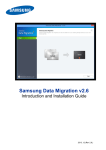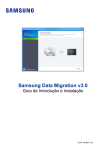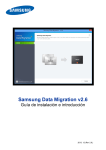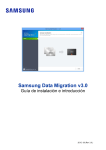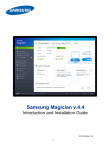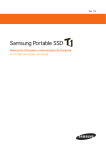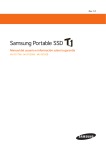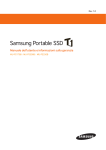Download Samsung Sata3 User's Manual
Transcript
Samsung SSD Self-Install Photo Guide for desktop computers © 2013 Samsung Electronics Co. Checking the Product 00 Installing the Program Data Migration Mounting the SSD Checking SSD Mounting 01 02 Bracket Package (installation program & manual CD instruction manual, warranty) SSD mounting spacer SATA cable SSD Self-Install Photo Guide for desktop computers Carefully open the SSD box. Make sure that there are no missing components! screws SATA to USB connector stickers Checking the Product 01 SSD Self-Install Photo Guide for desktop computers Installing the Program Data Migration Mounting the SSD Checking SSD Mounting 02 Remove the CD from the black document pouch, and insert it into the CD-ROM drive. You can also download the guide at www.samsung.com/samsungssd . (See next page) 03 Checking the Product 02 SSD Self-Install Photo Guide for desktop computers Installing the Program Data Migration Mounting the SSD Checking SSD Mounting 03 You can also download the program at the official Samsung SSD homepage. You can also download the guide at www.samsung.com/samsungssd . (SSD firmware, Magician software, Samsung Data Migration software) 04 Checking the Product 03 SSD Self-Install Photo Guide for desktop computers Installing the Program Data Migration Mounting the SSD Checking SSD Mounting 04 Install the Magician program. *Run the CD, then click the setup file in the Magician Software folder to install the program. 05 Checking the Product 04 SSD Self-Install Photo Guide for desktop computers Installing the Program Data Migration Mounting the SSD Checking SSD Mounting 05 Install the Data Migration program. Using Data Migration migrates all of the user's data including the OS. This means re-installation of the OS is not necessary. * Run the CD, then click the setup file in the Magician Software folder to install the program. 06 Checking the Product 05 SSD Self-Install Photo Guide for desktop computers Installing the Program Data Migration Mounting the SSD Checking SSD Mounting 06 Run the Data Migration program, and then connect the SSD to the computer. 1. On the main screen, click ‘Start’ to run the Data Migration program. 07 Checking the Product 06 SSD Self-Install Photo Guide for desktop computers Installing the Program Data Migration Mounting the SSD Checking SSD Mounting 07 Connect the SSD to the computer. 2. Connect the SSD to the desktop computer using the SATA to USB connector. 08 Checking the Product 07 SSD Self-Install Photo Guide for desktop computers Installing the Program Data Migration Mounting the SSD Checking SSD Mounting 08 Run the Data Migration program, and make sure to the SSD is detected in the program. 3. The Data Migration program will automatically detect the SSD. 09 Checking the Product 08 SSD Self-Install Photo Guide for desktop computers Installing the Program Data Migration Mounting the SSD Checking SSD Mounting 09 Click the ‘Start Migration’ button to start Data Migration. * Data Migration migrates the data and the operating system (Windows) installed on the computer you are using to the SSD you have purchased. * After data migration is complete, turn off the computer and then disconnect the SSD from the USB connector. 10 Checking the Product 09 SSD Self-Install Photo Guide for desktop computers Installing the Program Data Migration Mounting the SSD Checking SSD Mounting 10 Open the cover of your computer. * The details of how to open the cover differ between computer models. Refer to the service manual for your computer to open the cover safely. * You need to open the cover on the opposite side to remove the HDD. This is described in the next step. 11 Checking the Product 10 SSD Self-Install Photo Guide for desktop computers Installing the Program Data Migration Mounting the SSD Checking SSD Mounting 11 Disconnect all the cables that are connected to the original HDD (or existing SSD) in your computer. The cables that have been disconnected from the original HDD need to be reconnected to your new SSD. It is recommended that you mark these cables in some way so that they are not confused with other cables. 12 Checking the Product 11 SSD Self-Install Photo Guide for desktop computers Installing the Program Data Migration Mounting the SSD Checking SSD Mounting 12 Remove the HDD by unfastening the screws holding the HDD in the drive bay. 13 Checking the Product 12 SSD Self-Install Photo Guide for desktop computers Installing the Program Data Migration Mounting the SSD Checking SSD Mounting 13 Attach the bracket to the SSD. * The bracket is sold separately. (However, a bracket is included in the Desktop Kit and All-in-One Kit.) * The bracket may not be necessary, depending on the design of your computer. * Use four screws to fasten it securely in place. 14 Checking the Product 12 SSD Self-Install Photo Guide for desktop computers Installing the Program Data Migration Mounting the SSD Checking SSD Mounting 13 Attach the bracket to the SSD. * The bracket is sold separately. (However, a bracket is included in the Desktop Kit and All-in-One Kit.) * The bracket may not be necessary, depending on the design of your computer. * Use four screws to fasten it securely in place. 14 Checking the Product 13 SSD Self-Install Photo Guide for desktop computers Installing the Program Data Migration Mounting the SSD Checking SSD Mounting 14 Insert the SSD, fitted with the bracket, into the location of the original HDD (usually SATA port #0), and secure it in place. The HDD is usually mounted in SATA port #0, because booting starts at the lowest-numbered SATA port and then proceeds sequentially. (Port #0, port #1, port #2, and so on.) Therefore, you need to mount your new SSD in SATA port #0 (vacated by the existing HDD), which is the lowest-numbered SATA port. 15 Checking the Product 13 SSD Self-Install Photo Guide for desktop computers Installing the Program Data Migration Mounting the SSD Checking SSD Mounting 14 Insert the SSD, fitted with the bracket, into the location of the original HDD (usually SATA port #0), and secure it in place. The HDD is usually mounted in SATA port #0, because booting starts at the lowest-numbered SATA port and then proceeds sequentially. (Port #0, port #1, port #2, and so on.) Therefore, you need to mount your new SSD in SATA port #0 (vacated by the existing HDD), which is the lowest-numbered SATA port. 15 Checking the Product 14 SSD Self-Install Photo Guide for desktop computers Installing the Program Data Migration Mounting the SSD Checking SSD Mounting 15 Connect the cables that have been disconnected from the existing HDD to your new SSD. 16 Checking the Product 14 SSD Self-Install Photo Guide for desktop computers Installing the Program Data Migration Mounting the SSD Checking SSD Mounting 15 Connect the cables that have been disconnected from the existing HDD to your new SSD. 16 Checking the Product 15 SSD Self-Install Photo Guide for desktop computers Installing the Program Data Migration Mounting the SSD Checking SSD Mounting 16 Connect the existing HDD to the port with the next lowest number. For example, if the SSD is connected to port #0, then connect the HDD to port #1. 17 Checking the Product 15 SSD Self-Install Photo Guide for desktop computers Installing the Program Data Migration Mounting the SSD Checking SSD Mounting 16 Connect the existing HDD to the port with the next lowest number. For example, if the SSD is connected to port #0, then connect the HDD to port #1. 17 Checking the Product 16 SSD Self-Install Photo Guide for desktop computers Installing the Program Data Migration Mounting the SSD Checking SSD Mounting 17 Connect the SATA cable and the power cable to the reinstalled HDD. 18 Checking the Product 16 SSD Self-Install Photo Guide for desktop computers Installing the Program Data Migration Mounting the SSD Checking SSD Mounting 17 Connect the SATA cable and the power cable to the reinstalled HDD. 18 Checking the Product 17 SSD Self-Install Photo Guide for desktop computers Installing the Program Data Migration Mounting the SSD Checking SSD Mounting 18 Reattach the side covers to the computer. 19 Checking the Product 18 SSD Self-Install Photo Guide for desktop computers Installing the Program Data Migration Mounting the SSD Checking SSD Mounting 19 20 Reboot the computer, and immediately enter BIOS setup. Entering the BIOS setup may be done differently depending on mainboard and/or computer manufacturer. Usually, you can enter BIOS setup by pressing the Delete key or the F2 key before the boot sequence proceeds to Windows. Checking the Product 19 SSD Self-Install Photo Guide for desktop computers Installing the Program Data Migration Mounting the SSD Checking SSD Mounting 20 Change IDE mode to AHCI mode. * AHCI mode is usually found under advanced options. * Some mainboards may not support AHCI. (In this case you should obtain a separate driver from the manufacturer of the mainboard or the OS to maximize the performance of the SSD.) * Once installation is completed, install necessary drivers. 21 Checking the Product 20 SSD Self-Install Photo Guide for desktop computers Installing the Program Data Migration Mounting the SSD Checking SSD Mounting 21 When you boot up the computer, Windows will detect the new SSD automatically, and a message will advise you reboot the computer. * Once the desktop computer detects the newly mounted SSD, a message will advise you reboot the computer. This is normal, and you should reboot the computer. 22 Checking the Product 21 SSD Self-Install Photo Guide for desktop computers Installing the Program Data Migration Mounting the SSD Checking SSD Mounting 22 After rebooting, run the Magician program to verify that the SSD has been detected correctly. 23 Checking the Product 22 SSD Self-Install Photo Guide for desktop computers Installing the Program Data Migration Mounting the SSD Checking SSD Mounting 23 Check the AHCI mode and SATA interface settings. * If AHCI mode is enabled and the SSD is connected to SATA 3 as shown in the photo, run OS Optimization setup (in the left menu). * The SSD performs optimally when using AHCI mode and SATA 3. 24 Checking the Product 23 SSD Self-Install Photo Guide for desktop computers Installing the Program Data Migration Mounting the SSD Checking SSD Mounting 24 If you are using SATA 2, check whether your mainboard supports SATA 3. * If SATA 3 is supported, turn off your computer and connect the SSD using SATA 3. * If SATA 3 is not supported, proceed to the next step. For more information, please contact the manufacturer of your mainboard. 25 Checking the Product 24 SSD Self-Install Photo Guide for desktop computers Installing the Program Data Migration Mounting the SSD Checking SSD Mounting 25 After setup has completed, check OS optimization. * Run performance benchmark and performance optimization from the left menu to ensure optimal performance. * For more information, please refer to ‘Help’, located at the lower right corner. 26 Checking the Product 25 SSD Self-Install Photo Guide for desktop computers Installing the Program Data Migration Mounting the SSD Checking SSD Mounting 26 Place the SSD sticker in a prominent location. The installation and optimization of the SSD is now complete. Thank you. © 2013 Samsung Electronics Co. Samsung SSD Self Installation Photo Guide for desktop computers (reinstalling Windows) © 2013 Samsung Electronics Co. Checking the Product 00 Installing the Program Data Migration Mounting the SSD Checking SSD Mounting 01 02 Bracket Package (installation program & manual CD instruction manual, warranty) SSD mounting spacer SATA cable SSD Self-Install Photo Guide for desktop computers Carefully open the SSD box. Make sure that there are no missing components! screws SATA to USB connector stickers Checking the Product 01 SSD Self-Install Photo Guide for desktop computers Installing the Program Data Migration Mounting the SSD Checking SSD Mounting 02 Open the cover of your computer. * The details of how to open the cover differ between computer models. Refer to the service manual for your computer to open the cover safely. * You need to open the cover on the opposite side to remove the HDD. This is described in the next step. 03 Checking the Product 02 SSD Self-Install Photo Guide for desktop computers Installing the Program Data Migration Mounting the SSD Checking SSD Mounting 03 Disconnect all the cables that are connected to the original HDD (or existing SSD) in your computer. The cables that have been disconnected from the original HDD need to be reconnected to your new SSD. It is recommended that you mark these cables in some way so that they are not confused with other cables. 04 Checking the Product 03 SSD Self-Install Photo Guide for desktop computers Installing the Program Data Migration Mounting the SSD Checking SSD Mounting 04 Remove the HDD by unfastening the screws holding the HDD in the drive bay. 05 Checking the Product 04 SSD Self-Install Photo Guide for desktop computers Installing the Program Data Migration Mounting the SSD Checking SSD Mounting 05 Attach the bracket to the SSD. * The bracket is sold separately. (However, a bracket is included in the Desktop Kit and Allin-One Kit.) * The bracket may not be necessary, depending on the design of your computer. * Use four screws to fasten it securely in place. 06 Checking the Product 04 SSD Self-Install Photo Guide for desktop computers Installing the Program Data Migration Mounting the SSD Checking SSD Mounting 05 Attach the bracket to the SSD. * The bracket is sold separately. (However, a bracket is included in the Desktop Kit and Allin-One Kit.) * The bracket may not be necessary, depending on the design of your computer. * Use four screws to fasten it securely in place. 06 Checking the Product 05 SSD Self-Install Photo Guide for desktop computers Installing the Program Data Migration Mounting the SSD Checking SSD Mounting 06 Insert the SSD, fitted with the bracket, into the location of the original HDD. (usually SATA port #0), and secure it in place. The HDD is usually mounted in SATA port #0, because booting starts at the lowest-numbered SATA port and then proceeds sequentially. (Port #0, port #1, port #2, and so on.) Therefore, you need to mount your new SSD in SATA port #0 (vacated by the existing HDD), which is the lowest-numbered SATA port. 07 Checking the Product 05 SSD Self-Install Photo Guide for desktop computers 06 Installing the Program Data Migration Mounting the SSD Checking SSD Mounting 07 Insert the SSD, fitted with the bracket, into the location of the original HDD. (usually SATA port #0), and secure it in place. Checking the Product 06 SSD Self-Install Photo Guide for desktop computers Installing the Program Data Migration Mounting the SSD Checking SSD Mounting 07 Connect the cables that have been disconnected from the existing HDD to your new SSD. 08 Checking the Product 06 SSD Self-Install Photo Guide for desktop computers Installing the Program Data Migration Mounting the SSD Checking SSD Mounting 07 Connect the cables that have been disconnected from the existing HDD to your new SSD. 08 Checking the Product 07 SSD Self-Install Photo Guide for desktop computers Installing the Program Data Migration Mounting the SSD Checking SSD Mounting 08 Connect the existing HDD to the port with the next lowest number. For example, if the SSD is connected to port #0, then connect the HDD to port #1. 09 Checking the Product 07 SSD Self-Install Photo Guide for desktop computers Installing the Program Data Migration Mounting the SSD Checking SSD Mounting 08 Connect the existing HDD to the port with the next lowest number. For example, if the SSD is connected to port #0, then connect the HDD to port #1. 09 Checking the Product 08 SSD Self-Install Photo Guide for desktop computers Installing the Program Data Migration Mounting the SSD Checking SSD Mounting 09 Connect the SATA cable and the power cable to the reinstalled HDD. 10 Checking the Product 08 SSD Self-Install Photo Guide for desktop computers Installing the Program Data Migration Mounting the SSD Checking SSD Mounting 09 Connect the SATA cable and the power cable to the reinstalled HDD. 10 Checking the Product 09 SSD Self-Install Photo Guide for desktop computers Installing the Program Data Migration Mounting the SSD Checking SSD Mounting 10 Reattach the side covers to the computer. 11 Checking the Product 10 SSD Self-Install Photo Guide for desktop computers Installing the Program Data Migration Mounting the SSD Checking SSD Mounting 11 Turn on the computer, and install Windows. 12 Checking the Product 11 SSD Self-Install Photo Guide for desktop computers Installing the Program Data Migration Mounting the SSD Checking SSD Mounting 12 13 Reboot the computer, and immediately enter BIOS setup. Entering the BIOS setup may be done differently depending on mainboard and/or computer manufacturer. Usually, you can enter BIOS setup by pressing the Delete key or the F2 key before the boot sequence proceeds to Windows. Checking the Product 12 SSD Self-Install Photo Guide for desktop computers Installing the Program Data Migration Mounting the SSD Checking SSD Mounting 13 Change IDE mode to AHCI mode. * AHCI mode is usually found under advanced options. * Some mainboards may not support AHCI. (In this case you should obtain a separate driver from the manufacturer of the mainboard or the OS to maximize the performance of the SSD.) * Once installation is completed, install necessary drivers. 14 Checking the Product 13 SSD Self-Install Photo Guide for desktop computers Installing the Program Data Migration Mounting the SSD Checking SSD Mounting 14 Install the Magician program using the CD provided. * Run the CD located in the black document pouch, then click the setup file in the Magician Software folder to install the program * You can also download the program and the guide at www.samsung.com/samsungssd 15 Checking the Product 14 SSD Self-Install Photo Guide for desktop computers Installing the Program Data Migration Mounting the SSD Checking SSD Mounting 15 You can also download the program at the official Samsung SSD homepage. You can also download the program and the guide at www.samsung.com/samsungssd (SSD firmware, Magician software, Samsung Data Migration software) 16 Checking the Product 15 SSD Self-Install Photo Guide for desktop computers Installing the Program Data Migration Mounting the SSD Checking SSD Mounting 16 After running the Magician program, verify that the SSD has been detected correctly. 17 Checking the Product 16 SSD Self-Install Photo Guide for desktop computers Installing the Program Data Migration Mounting the SSD Checking SSD Mounting 17 Check the AHCI mode and SATA interface settings. * If AHCI mode is enabled and the SSD is connected to SATA 3 as shown in the photo, run OS Optimization setup (in the left menu). * The SSD performs optimally when using AHCI mode and SATA 3. 18 Checking the Product 17 SSD Self-Install Photo Guide for desktop computers Installing the Program Data Migration Mounting the SSD Checking SSD Mounting 18 If you are using SATA 2, check whether your mainboard supports SATA 3. * If SATA 3 is supported, turn off your computer and connect the SSD using SATA 3. * If SATA 3 is not supported, proceed to the next step. For more information, please contact the manufacturer of your mainboard. 19 Checking the Product 18 SSD Self-Install Photo Guide for desktop computers Installing the Program Data Migration Mounting the SSD Checking SSD Mounting 19 After setup has completed, check OS optimization. * Run performance benchmark and performance optimization from the left menu to ensure optimal performance. * For more information, please refer to ‘Help’, located at the lower right corner. 20 Checking the Product 19 SSD Self-Install Photo Guide for desktop computers Installing the Program Data Migration Mounting the SSD Checking SSD Mounting 20 Place the SSD sticker in a prominent location. * The installation and optimization of the SSD is now complete. Thank you. © 2013 Samsung Electronics Co.





























































